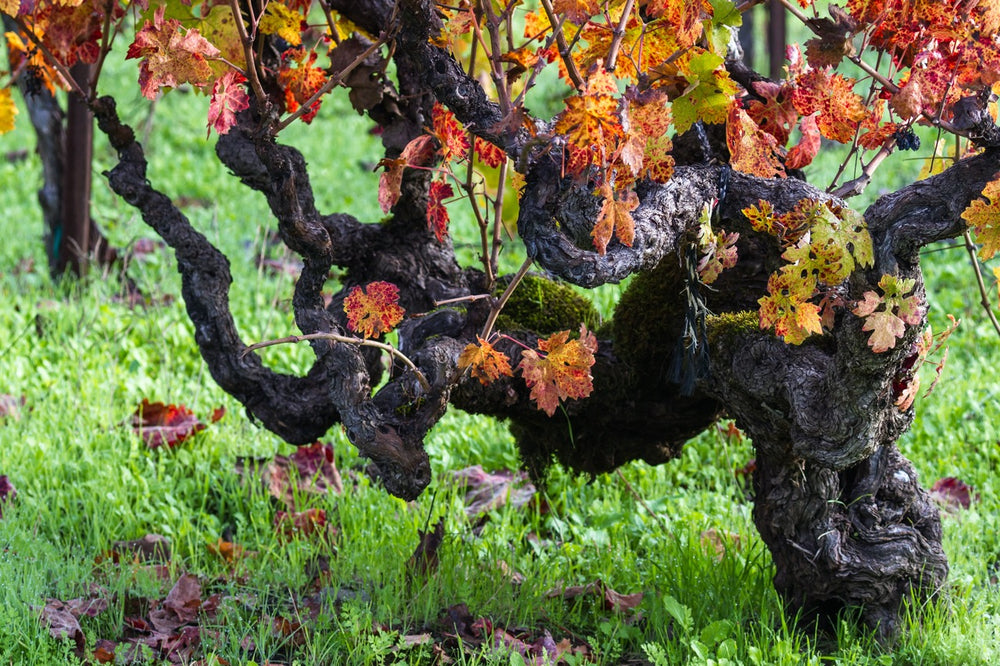
“We plant the vineyards for our children and olive trees for our grandchildren,” the saying goes. Planting a vineyard and having a winery is not an easy task. It is true that vineyards take a few years to produce fruit and up to seven to recover expenses. But this blog is not about accounting for a vineyard. Today we're going to get the skinny on the importance old vineyards. And how does a wine aged in the cellar for decades improve over time? We are not going to talk about olive trees either, but it is true that these trees require much more time than the vine to obtain their fruits. In both cases, these plants and nature teach us the value of patience and remind us of the beauty that occurs when we live life more slowly.
Let's start with the vineyards. Since the wine starts there, it seems appropriate. The grapevine is a vigorous plant by nature. Planting it in super fertile soils requires more control for annual pruning, as well as the appropriate training system and the grape variety for that particular parcel. If this annual process is not well controlled, it can have too much vigor in the vegetative part of the vine and not enough in the fruit. This is the balance that a good winegrower knows about his vineyards, knowing that there are likely different types of soil and vigor within a few meters.
A young vine, like all young things, wants to grow, it wants to spread its branches to be bigger. In this case, the sugar that the plant produces during the photosynthesis process goes to the branches and may not develop the sugar in the grapes well. As time passes and the plant is more rooted in its soil, the roots are larger. They are able to dig deeper to find water in the subsoil and better absorb the nutrients available in the soil. If a difficult year comes – which has happened a lot in recent years – they are able to overcome it with their deeper root system. Basically, the plant is more established and the fruit that comes out is usually of better quality and therefore, so is the wine. A vineyard can last more than a hundred years and produce better wine each year if it is well cared for and pruned. But it is surprising how this incredible plant wants to survive so much that when the vineyard is abandoned, it can be rehabilitated and will produce high quality fruit in just a few harvests. Once again we see the enormous capacity that the vine has to adapt, to survive and to continue giving the world its wonderful elixir: wine.

And what's up with wine aging? There is no doubt that wine and its ability to age is what separates it from the rest of the drinks in the world. However, if you don't have the right conditions, things won't go very well. The bottles have to be kept at a cool, slightly humid, and stable temperature. You can't age wine in your attic. Preferably, the place has a temperature around 15-16 Centigrade. Another very important element is that the wine has to have the ability to age. Not all of them do. Acidity, pH, tannin for reds and balance in general – which comes from practices in the vineyard – are essential for a bottle to improve over time. If you have an astringent wine with overripe fruit that does not have enough acidity, time in the cellar will not improve it.
There are two stages of aging: when the wine is still in the process of being made in a barrel (or tank, concrete, amphora, etc.) and when the process is finished and it is already in the bottle. In both stages, the wine must be exposed to as little oxygen as possible. However, some interaction is necessary. For red wines, the tannins (the polyphenolics that come from the seeds and skins) slowly oxidize and their chemical structure begins to break down in a way. We use the word “open” to describe tannins that soften over time. It is the same process that happens in your glass when in contact with air or in a decanter: you are volatilizing the wine, opening these tannins and esters – the chemical compounds that make aromas – with oxygen, much faster than leaving to rest in the cellar. To age it, we want this process to be as slow as possible, and for there to be a little air that enters through the cork or in the case of the barrel, due to the evaporation of the wine that occurs inside it.

Generally, the lower the pH of a wine, the better it will age. This is a generalization of course. It cannot be too low and the other acids: primarily tartaric, malic and citric, have to be correct. Over time, we know that in red wines the color can be more violet or red when the wine is young and more brick-colored when it ages, this is normal. And the whites have a slightly browner color with longer time in the cellar. At the same time as the color is changing, the smells and flavors are also changing. At first when the wine is young, we call its aromas and flavors “primary fruit,” which means the flavors are vibrant and sometimes simpler. But over time they develop more complex flavors that are called “secondary and tertiary fruits”, when the flavors of the earth mix with the fruit and the tannins soften it, making it more elegant. It's a somewhat unpredictable process in terms of the perfect moment to open the bottle without knowing when it will change again. A winemaker of his own wine has the best understanding, of course, however, wine professionals become accustomed to the structure of different wines and when this is taken into account with the vintage and practices of a producer, a closer approximation can be made as to the ideal time to drink it. And then, cross your fingers!
The way to learn about this all really is just to try more wines and learn to know how you like wines. Someone else's opinion doesn't matter. It's your glass! Whether you prefer them to be young or old is totally subjective.
It is important to mention that I am writing a blog to take some of the mystery out of wine in a way that I hope is interesting on all levels to get to know it better. This is a short summary made to fit in this space. There is much more information about how, when, and why to age wine and the science behind the entire process. In general, acidity, balance and tannin, as well as a cool and consistent temperature location, are the most important things to achieve aging. But the most valuable thing is that you enjoy the process of trying and discovering your palate. The best things are always worth the wait!




